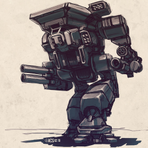Hi guys,
i am trying to implement a simple font renderer using bitmap font texture with a dynamic vertex buffer, i am able to successfully display text with correct glyph from bitmap texture.
right now i am trying to draw a dynamic string that changes at user input, i.e user able change the displayded text by typing the new one.
The issue is that length of string is exactly same as what it was initialized with even when updating string at every render frame. string gets updated every fram but is capped at length equal to what is was initialized with.
i am suspecting that vertexBufferDesc.ByteWidth is not getting updated even when i update vertexbuffer by map and unmap it.
initialize
bool GlyphClass::Initialize(ID3D11Device* device, HWND hwnd, int screenWidth, int screenHeight, WCHAR* path)
{
bool result;
m_GlyphWidthData.open("Font/AgencyFBFont_64x64_width.txt");
while (1)
{
if (m_GlyphWidthData.eof())
{
break;
}
int tmp = 0;
m_GlyphWidthData >> tmp;
if (tmp != 0)
{
m_GlyphWidth.push_back(tmp);
}
}
m_GlyphWidthData.close();
m_GlyphCharacter = 'A';
m_StringToDraw = "TEXTTEST@xyz";//userInputString != "" ? userInputString : "VIVEK599 xyz";
m_fontTextureShader = new TextureShaderClass;
if (!m_fontTextureShader)
{
return false;
}
result = m_fontTextureShader->Initialize(device, hwnd);
if (!result)
{
MessageBox(hwnd, L"Could not initialize font texture shader object!", L"Error", MB_OK);
return false;
}
m_ScreenWidth = screenWidth;
m_ScreenHeight = screenHeight;
result = InitializeBuffers(device);
if (!result)
{
return false;
}
result = LoadTexture(device, path);
if (!result)
{
return false;
}
return true;
}updatebuffer
bool GlyphClass::UpdateBuffers(ID3D11DeviceContext* context, int posX, int posY)
{
m_StringToDraw = userInputString != "" ? userInputString : "STRING 555@xyz0123456789";
VertexType* vertices;
D3D11_MAPPED_SUBRESOURCE mappedResource;
VertexType* vertexPtr;
HRESULT hr;
vertices = new VertexType[m_VertexCount * m_StringToDraw.length()];
if (!vertices)
{
return false;
}
// Initialize vertex array to zeros at first.
memset(vertices, 0, sizeof(VertexType) * m_VertexCount * m_StringToDraw.length() );
float posXOffset = (float)posX;
float posYOffset = (float)posY;
for ( int i = 0; i < m_StringToDraw.length(); i++ )
{
int cx = m_StringToDraw[i] % 16;
int cy = m_StringToDraw[i] / 16;
float tex_left = (float)cx * (1.f / 16.f);
float tex_top = (float)cy * (1.f / 16.f);
float tex_right = tex_left + (1.f / 16.f) * ((float)m_GlyphWidth[m_StringToDraw[i]] / 64.f);
float tex_bottom = tex_top + (1.f / 16.f);
int totalCharWidth = 64;
float left = (float)((float)(m_ScreenWidth / 2.f) * -1) + posXOffset;
float right = left + (float)m_GlyphWidth[m_StringToDraw[i]];
float top = (float)(m_ScreenHeight / 2.f) - posYOffset;
float bottom = top - (float)totalCharWidth;
//triangle 1 - clockwise
vertices[0 + m_VertexCount * i].position = Vector3(left, top, 0.f);
vertices[0 + m_VertexCount * i].texture = Vector2(tex_left, tex_top);
vertices[1 + m_VertexCount * i].position = Vector3(right, bottom, 0.f);
vertices[1 + m_VertexCount * i].texture = Vector2(tex_right, tex_bottom);
vertices[2 + m_VertexCount * i].position = Vector3(left, bottom, 0.f);
vertices[2 + m_VertexCount * i].texture = Vector2(tex_left, tex_bottom);
//triangle + i 2
vertices[3 + m_VertexCount * i].position = Vector3(left, top, 0.f);
vertices[3 + m_VertexCount * i].texture = Vector2(tex_left, tex_top);
vertices[4 + m_VertexCount * i].position = Vector3(right, top, 0.f);
vertices[4 + m_VertexCount * i].texture = Vector2(tex_right, tex_top);
vertices[5 + m_VertexCount * i].position = Vector3(right, bottom, 0.f);
vertices[5 + m_VertexCount * i].texture = Vector2(tex_right, tex_bottom);
posXOffset += m_GlyphWidth[m_StringToDraw[i]];
}
hr = context->Map(m_VertexBuffer, 0, D3D11_MAP_WRITE_DISCARD, 0, &mappedResource);
if (FAILED(hr))
{
return false;
}
vertexPtr = (VertexType*)mappedResource.pData;
int bufferSize = sizeof(VertexType) * m_VertexCount * m_StringToDraw.length();
memcpy(vertexPtr, (void*)vertices, bufferSize);
D3D11_BUFFER_DESC tmpDesc;
m_VertexBuffer->GetDesc(&tmpDesc);
context->Unmap(m_VertexBuffer, 0);
delete[] vertices;
vertices = 0;
return true;
}





